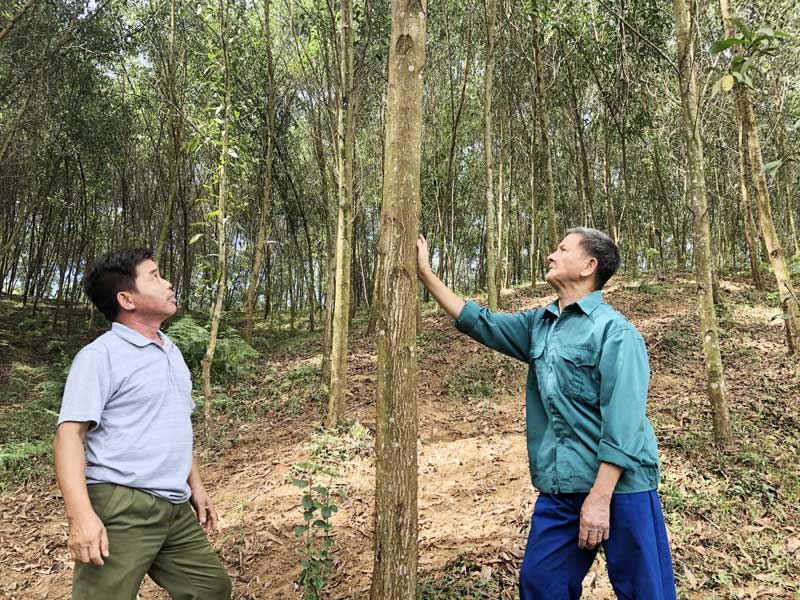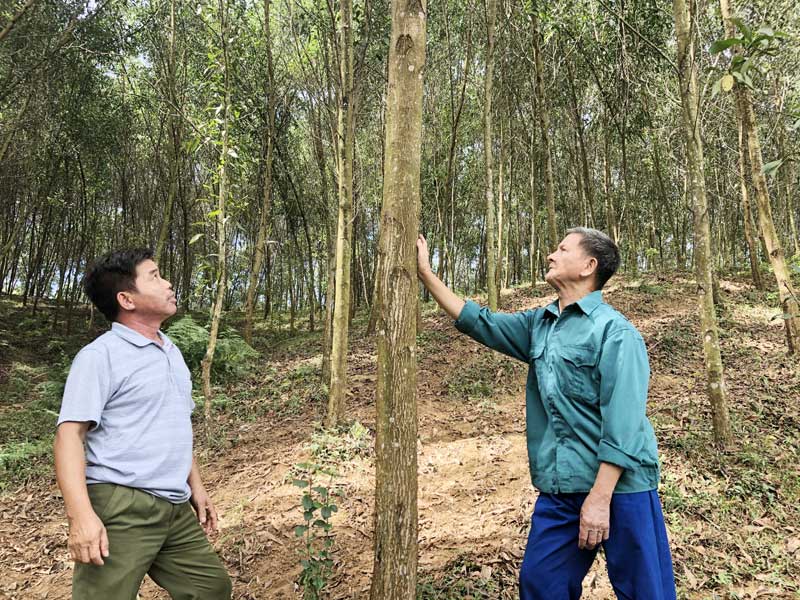
(HBO) – In 2016, the agriculture extension centre of Hoa Binh province launched a project on developing a model for synchronously applying technical advances to planting fast-growing large-timber forests. This project covered 38ha of land with 20 households participating. After four years of implementation, up to 95-98 percent of the trees planted under this project have survived with even growth, height of 10-12m and trunks 15-20cm in diameter.
 Bui
Van Danh (right), a resident in Bin hamlet of Tu Ne commune (Tan Lac district),
shares experience in planting fast-growing large-timber forests with other
locals.
Bui
Van Danh (right), a resident in Bin hamlet of Tu Ne commune (Tan Lac district),
shares experience in planting fast-growing large-timber forests with other
locals.
Planting large-timber forests is useful for
saving seedling and care-related expenses while improving economic efficiency
on a same area of cultivation (large-timber forests generate value three-four
times higher than that of small-timber ones) and minimising pests and diseases
on trees as well as land degradation.
To carry out the project in Tan Lac, the
provincial agriculture extension centre provided seedlings for local
households. The chosen varieties are BV10, BV16 and BV32 of Acacia hybrid.
Tan Lac district boasts huge potential for
forestry development. The district has zoned more than 33,300ha of land for
forestry, including over 25,000ha already under forest.
However, locals have yet to fully capitalise on
the forestry development potential but just exploited young and small trees for
raw materials and wood chips. Besides, their cultivation practices are out of
date and mainly focus on extensive farming, instead of intensive farming and
improving forest productivity and quality.
Basing on the provincial agriculture and rural
development’s policy of converting small-timber forests into large-timber ones
for more profit, authorities of Tan Lac have boosted communications to
encourage people to adopt growing large-timber forests while sending staff from
the district’s agricultural services centre and agriculture extension workers
of local communes to monitor forest development.
As a result, local residents have gradually
realised the importance of the intensive farming of large-timber forests and
changed their practices. After nearly four years of project implementation,
though the planted trees haven’t matured enough for exploitation, experts and
locals said they have seen initial encouraging outcomes in planting
fast-growing large-timber forests and believe that the practice will become
profitable and help protect the environment./.
The emulation movement "Hoa Binh joining hands to build new-style rural areas” has been widely spreading, becoming a driving force that motivates the localities to renew rural landscapes and improve the material and spiritual lives of the residents. In this movement, the people play a central role-both as the main implementers and direct beneficiaries of its outcomes.
In response to the global digital revolution, Hoa Binh Newspaper is transforming itself into a modern and multi-platform media hub, blending cutting-edge technology with a restructured newsroom and a new generation of tech-savvy journalists.
Hoa Binh province’s Association of the Elderly recently held a conference to review the project on expanding the inter-generation self-help club model until 2025.
In a move to implement Resolution No. 57-NQ/TW, issued on December 22, 2024 by the Politburo, which targets breakthroughs in science-technology development, innovation, and digital transformation, the Hoa Binh provincial Department of Health has issued a plan to roll out the "Digital Literacy for All” campaign within the local health sector.
An Nghia Commune (Lạc Sơn District) is one of the communes that achieved the tha standard of the national new rural area in 2018. Entering a new development phase, the commune is now trying to meet the criteria for the advanced new rural development. With the strong political will and the public consensus, the commune is gradually overcoming the challenges to reach this goal, aiming for the sustainable development.



 Bui
Van Danh (right), a resident in Bin hamlet of Tu Ne commune (Tan Lac district),
shares experience in planting fast-growing large-timber forests with other
locals.
Bui
Van Danh (right), a resident in Bin hamlet of Tu Ne commune (Tan Lac district),
shares experience in planting fast-growing large-timber forests with other
locals.